Introduction
The minimum standard of infrastructure that’s considered acceptable for people walking, wheeling and cycling is changing rapidly. This is really good news for Disabled people and others who need improved accessibility, as the changes mean that new and refurbished public spaces should become much more usable for us in future years.
But we know it’s a lot to take in for people involved in creating schemes – and there are both legitimate concerns and understandable misconceptions that we need to talk about.
At Wheels for Wellbeing we’re releasing a series of guidance sheets for local authorities, NGOs, other organisations involved in decisions about walking, wheeling and cycling schemes and for anyone with an interest in active travel infrastructure. Hopefully, these guidance sheets will help explain the reasoning behind different aspects of accessible infrastructure design.
These guidance sheets are aligned with our Guide to Inclusive Cycling (5th edition due autumn 2023). They may be printed, electronically distributed or quoted provided credit is given to Wheels for Wellbeing.
Download the RADAR locking barriers guidance sheet as a Word document
Download the RADAR locking barriers guidance sheet as a pdf
RADAR barriers are inaccessible:
RADAR locks are commonly used on Disabled toilets and similar facilities to prevent vandalism and illegitimate use.
RADAR locks are sometimes installed on gates and access barriers. The idea is that these will allow Disabled people using mobility aids to open the barriers wide enough to get through, while still preventing motorcycle access to traffic-free spaces.
However, many Disabled people cannot use RADAR locks independently, so RADAR locks will often prevent Disabled people from opening the barrier.
This means that RADAR locks do not enable access and should not be used.
This video shows how inaccessible RADAR barriers are: https://www.youtube.com/watch?v=_kHVKSvqbww
How to make barrier-free, inclusive, safer places:
Making a place feel welcoming to everyone will encourage regular use by a wide range of people. This will make it safer.
We can make places feel more welcoming by:
- Removing all access barriers, including RADAR locking barriers, so everyone has easy access to the space;
- Providing amenities that encourage legitimate community use of the area, including well-designed seating;
- Improving natural or passive surveillance by:
- Removing unnecessary signs and fencing;
- Cutting vegetation back from paths, especially at corners;
- Encouraging building owners and developers to build homes and businesses which overlook and are open onto green spaces;
- Improving lighting, in some situations.
- Supporting positive use with community education campaigns e.g. signage made by local children.
It’s best to have no access barriers at all. But if cars or vans often drive illegally on a traffic-free space and other measures like education and enforcement aren’t working, bollards spaced with 1.5m minimum air gaps between them can be used to prevent harm to people and the environment.
RADAR locks 1:
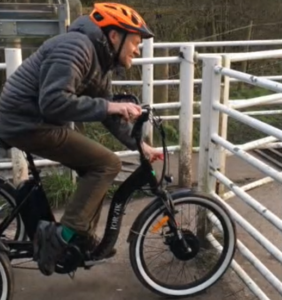
Opening RADAR locks on access barriers is often impossible for Disabled people
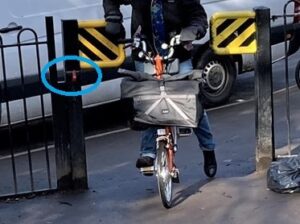
To open and close this RADAR padlock (circled blue), people must be able to reach around a post!
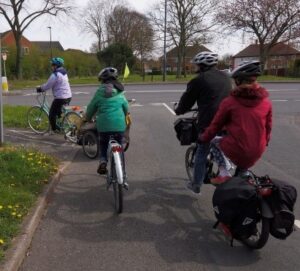
Barrier-free routes enable inclusive cycling
Legal & guidance position on RADAR barriers:
Equality Act (2010):
These duties are anticipatory: All reasonable adjustments to make a space equitably accessible for Disabled people legally must be taken without any Disabled person having to ask for them.
Section 20: Requires those responsible for a space to anticipate and make reasonable adjustments to enable Disabled people access with no substantial disadvantage compared to non-Disabled people. This explicitly includes including altering and removing physical features which would otherwise exclude Disabled people.
It is not permitted to require a Disabled person to go a longer way around, ask for assistance or traverse a space much more slowly than a non-Disabled person would have to due to a physical barrier that could be removed.
Section 149 Public Sector Equality Duty: Requires public authorities to advance equality of opportunity for all people with protected characteristics, including Disabled people.
This goes beyond removing and minimising disadvantages, and additionally includes taking steps to promote equality by actively enabling Disabled people to participate in public life and activities, especially where Disabled participation is disproportionately low (e.g. active travel).
Cycle Infrastructure Design LTN 1/20:
Section 1.6 summary principle 16: “Access control measures… should not be used. They reduce the usability of a route for everyone, and may exclude people riding nonstandard cycles and cargo bikes. They reduce the capacity of a route as well as the directness and comfort. Schemes should not be designed in such a way that access controls, obstructions and barriers are even necessary”.
Good practice:
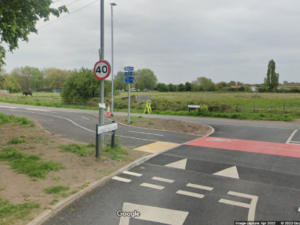
Most pedestrian and cycle route accesses don’t need any barriers
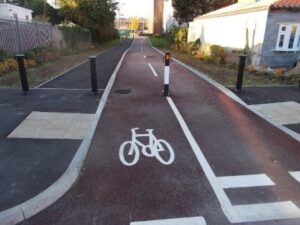
1.5m between bollards that are set back from the junction with a straight approach plus separate pedestrian and cycle paths make this route inclusive. The lockable central bollard lets emergency vehicles use the cycle path to avoid traffic.
References/Further reading/Resources:
- Equality Act (2010): https://www.legislation.gov.uk/ukpga/2010/15/contents
- LTN 1/20 Cycle infrastructure design: https://www.gov.uk/government/publications/cycle-infrastructure-design-ltn-120
- Wheels for Wellbeing Guide to Inclusive Cycling (4th edition, 2020): https://wheelsforwellbeing.org.uk/campaigning/guide/
